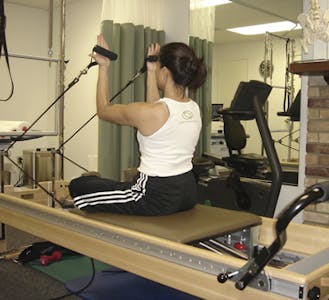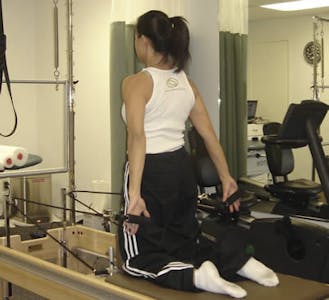Our staff includes physical therapists who are specifically trained in Pilates for Rehabilitation. Pilates has achieved its recognition by MDs, osteopaths, chiropractors, podiatrists; occupational therapists; massage therapists and others. It offers key exercises for dynamic spinal stabilization, which involves multi-joint, multi-planar and full body exercises while complementing all other traditional concepts. It is a comprehensive system, which improves all facets of movement: range of motion, flexibility, strength, quality, precision, control, coordination, endurance, and use of breath.
Emphasizes Core Trunk Muscles:
- Transverse Abdominals
- Obliques
- Rectus Abdominus
- Quadratus Lumborum
- Deep Postural Muscles
- Spine Extensors and Rotators
- Scapular Stabilizers
- Gluteal Muscles
- Hip Adductors
- Hip External Rotators
- Pelvic Floor
Promotes motor control via:
- Isometric Muscle Actions
- Concentric Muscle Actions (Shortening)
- Eccentric Muscle Actions (Lengthening)
Also...
- Promotes stimulation in neuro-muscular training: kinesthetic awareness; proprioception; tactile, and visual senses.
- Facilitates functional rehabilitation in peripheral joints through open and closed kinetic chain.
- Training in all functional positions: supine, prone, sitting, kneeling, standing and quadruped (all fours).
- Progresses from basic to intermediate, advanced levels through neutral spine stabilization to segmental/articulated movement of the spine.
Who Benefits?
- Patients with musculoskeletal injuries: disc bulging, sciatica, degenerative disc disease; post-operative cases; peripheral joint dysfunctions; ankle strain/sprain; osteoarthritis; rheumatoid arthritis; plantar fasciitis; patellofemoral syndromes and more.
- Expectant mothers with gestational sciatica; back pain.
- Women who have undergone hysterectomy and C-sections
- Mothers with post-natal dysfunctions; pelvic floor weakness; incontinence; abdominal weakness.
- Patients with multiple sclerosis, fibromyalgia, lupus.
- Patients with poor postures and alignments: scoliosis; excessive kyphosis and lordosis; forward head; genu valgum; genu varus; hyper/hypo mobility.
- High level athletes: dancers, ice skaters, swimmers, tennis players, ball players, hikers, runners.
- Performing artists: stuntmen; singers, actors, musicians.
- People of all ages who need to improve body awareness and biomechanics at home or work.




